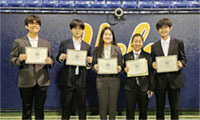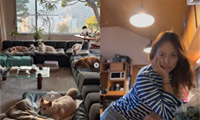▶ In Arabian sands, a green vision is lofty but socially questionable.
The city, called Masdar, would be a perfect square, about a kilometer and a half on each side, raised on a 7-meter-high base to capture desert breezes. Beneath its labyrinth of pedestrian streets, a fleet of driverless electric cars would navigate silently through dimly lit tunnels. The project conjured both a walled medieval fortress and an upgraded version of Tomorrowland at Disney World.
Well, those early assessments turned out to be wrong. By late September, as people began moving into the first section of the project to be completed - a 1.4-hectare zone surrounding a sustainabilityoriented research institute - it was clear that Masdar is something more daring and more noxious.
The place blends high-tech design and ancient construction practices into an intriguing model for a sustainable community, but it also reflects the gated-community mentality that has been spreading like a cancer around the globe. Its utopian purity, and its isolation from the life of the real city next door, are grounded in the belief that the only way to create a truly harmonious community is to cut it off from the world at large.
The city’s designer, Foster & Partners, a firm known for feats of technological wizardry, has worked in an alluring social vision, in which local tradition and the drive toward modernization are no longer in conflict.
Norman Foster, the principal partner, said he began with a meticulous study of old Arab settlements, including the ancient citadel of Aleppo in Syria and the mud-brick apartment towers of Shibam in Yemen, which date from the 16th century. “The point,” he said, “was to go back and understand the fundamentals,” how these communities had been madelivable in a region where the air can feel as hot as 65 degrees Celsius.
Among the findings his office made was that settlements were often built on high ground, not only for defensive reasons but also to take advantage of the stronger winds. Some also used tall, hollow “wind towers” to funnel air down to street level. And the narrowness of the streets - which were almost always at an angle to the sun’s east-west trajectory, to maximize shade - accelerated airflow through the city.
Mr. Foster’s team estimated that by combining such approaches, they could make Masdar feel as much as nearly 50 percent cooler. In so doing, they could more than halve the amount of electricity needed to run the city. Of the power that is used, 90 percent is expected to be solar, and the rest generated by incinerating waste (which produces far less carbon than piling it up in dumps). Masdar is 30 kilometers from downtown Abu Dhabi. You follow a narrow road past an oil refinery and through desolate patches of desert before reaching the blank concrete wall of Masdar and find the city looming overhead. From there a road tunnels through the base to a garage just underneath the city’s edge.
Stepping out of this space into one of the “Personal Rapid Transit” stations brings to mind the sets designed by Harry Lange for “2001: A Space Odyssey.” You are in a large, dark hall facing a row of white, pod-shaped cars lined up in rectangular glass bays. Daylight spills down a rough concrete wall behind them, hinting at the life above.
The first 13 futuristic electric cars of a proposed fleet of hundreds were being tested the day I visited, but as soon as the system is up, within a few weeks, a user will be able to step into a car and choose a destination on an LCD screen. The car will then silently pull into traffic, seeming to drive itself through a network of routes below the city’s raised ground level. There are no cables or rails.
It’s only as people arrive at their destination that they will become aware of the degree to which everything has been engineered for high-function, low-consumption performance.
The station’s elevators have been tucked discreetly out of sight to encourage use of a concrete staircase that corkscrews to the surface. And on reaching the streets - which were pretty breezy the day I visited - the only way to get around is on foot.
The buildings that have gone up so far come in two styles. Laboratories devoted to developing new forms of sustainable energy and affiliated with the Massachusetts Institute of Technology are housed in big concrete structures that are clad in pillowlike panels of ethylene-tetrafluoroethylene, a super-strong translucent plastic that has become fashionable in contemporary architecture circles for its sleek look and durability. Inside, big open floor slabs are designed for maximum flexibility.
The residential buildings, which for now will mostly house professors, students and their families, use a more traditional architectural vocabulary. An undulating facade of concrete latticework is based on the mashrabiya screens common in the region. The latticework blocks direct sunlight and screens interiors from view, while the curves make for angled views to the outside, so that apartment dwellers never look directly into the windows of facing buildings. Like many Middle Eastern university campuses, the neighborhood is segregated by sex, with women and families living at one end and single men at the other. Each end has a small public plaza, which acts as its social heart.
Mr. Foster’s most radical move was the way he dealt with one of the most vexing urban design challenges of the past century: what to do with the car. Not only did he close Masdar entirely to combustion-engine vehicles, he buried their replacement - his network of electric cars - underneath the city. Traditional cars are stopped at the edges.
Still, one wonders, despite the technical brilliance and the sensitivity to local norms, how Masdar can ever attain the richness and texture of a real city. Eventually, a lightrail system will connect it to Abu Dhabi, and street life will undoubtedly get livelier as the daytime population grows to a projected 90,000. Mr. Foster said the city was intended to house a cross-section of society, from students to service workers. “It is not about social exclusion,” he added.
And yet Masdar seems like the fulfillment of that idea. Ever since the notion that thoughtful planning could improve the lot of humankind died out, sometime in the 1970s, both the megarich and the educated middle classes have increasingly found solace by walling themselves off inside a variety of mini-utopias.
This has involved not only the proliferation of suburban gated communities, but also the transformation of city centers in places like Paris and New York into playgrounds for tourists and the rich. Masdar is the culmination of this trend: a selfsufficient society, lifted on a pedestal and outside the reach of most of the world’s citizens.
Carbon-free Masdar rises squarely from the Abu Dhabi desert to catch cooling breezes. The Masdar Institute of Science and Technology.
A country built on oil money has invested in a sustainable city. The dome of the library building at the Masdar Institute of Science and Technology.
스마터리빙
more [ 건강]
[ 건강]이제 혈관 건강도 챙기자!
[현대해운]우리 눈에 보이지 않기 때문에 혈관 건강을 챙기는 것은 결코 쉽지 않은데요. 여러분은 혈관 건강을 유지하기 위해 어떤 노력을 하시나요?
 [ 건강]
[ 건강]내 몸이 건강해지는 과일궁합
 [ 라이프]
[ 라이프]벌레야 물럿거라! 천연 해충제 만들기
 [ 건강]
[ 건강]혈압 낮추는데 좋은 식품
[현대해운]혈관 건강은 주로 노화가 진행되면서 지켜야 할 문제라고 인식되어 왔습니다. 최근 생활 패턴과 식생활의 변화로 혈관의 노화 진행이 빨라지고
사람·사람들
more많이 본 기사
- 널뛰는 환율에, 뒤돌아서니 1000만 원 손해
- 현대차·기아, 11월 돌려받는 관세만 ‘1400억’
- 韓 ‘집값 빈부격차’ 커져 상하위 10%, 45배 차
- ‘한국 핵잠·우라늄 농축’ 팩트시트 못박았다
- ‘이효리♥’ 이상순, 60억 평창동 家 거실의 가을..행복이 가득
- 몸값 4천400% 뛴 이트륨…中 희토류 통제로 항공·반도체 비상
- 3500억불 투자 MOU 서명… “조선 협력 수익은 전액 한국에”
- 트럼프 “베네수엘라 겨냥 다음단계 조치 결심…내용은 말못해”
- 트럼프, 사우디 빈살만 ‘국제 왕따’… 1
- 애플, 워치 혈중산소 측정 특허소송 패소…6억3천400만 달러 배상 평결
- 캘리포니아서 ‘저소득층에 쓰자’ 억만… 1
- 나나, 자택에 침입한 강도 제압..소속사 측 “경찰 수사 중”
- [신앙 에세이] “할아버지와 안경”
- ‘사망설’ 前엑소 크리스 누구..강간 혐의로 복역·강제 거세 가능성 “징역 후 캐나다로 추방”
- 워싱턴 한인 2세 기업, 미국서‘일냈… 1
- 농축산물 개방 막았지만… 미국산 LMO(유전자변형생물체) 감자 도입 빨라진다
- “백악관 연일 안보라인 소집…베네수엘라 타격 여부 저울질”
- 타깃 이어 월마트도…유통공룡들 잇따라… 1
- 뉴욕시 아파트 도로변에 대형 밀폐 쓰… 1
- ‘직무유기’ 조태용, 구속적부심 청구… “증거인멸 우려 없어”
- ‘마두로 압박’ 美·트리니다드토바고 또 합동 군사훈련
- 워런 버핏의 버크셔, 구글 알파벳 주식 43억 달러대 매입
- “방시혁 잘못 있다면 벌받겠지..뉴진스랑 왜 섞어?” 1000곡 ‘저작권료 부자’ 윤일상, 또 소신 발언
- 트럼프, 커피·열대과일등 일부 농산물에 국가별관세 면제지시
- “오타니·야마모토 WBC 불참했으면” 로버츠 솔직 고백→김혜성에도 영향 미치나
- 구글, 텍사스에 데이터센터 한꺼번에 … 1
- 뉴욕증시, AI 칩 감가상각 논란 확산…혼조 마감
- 美국방차관 “韓은 모범동맹…NATO외 ‘GDP 3.5% 국방비’ 첫국가”
- 김수현, 20억원 소송 시작됐다..재판부 “귀책 사유 특정해달라” 손배소 첫 변론기일서 요청
- 최장 셧다운 끝났지만… 후폭풍은 지속된다
- 美, 1급기밀로 알리바바 주시… “中정부와 군사적 연계”
- 강성훈, 친동생과 듀오 ‘강남매’ 결… 1
- ‘중국 쉬인 입점’ 파리 백화점서 유… 1
- 한인 향군단체들 베테런스데이 퍼레이드 참가
- 뉴욕주 ‘가스레인지 퇴출’ 일단 보류 1
- 여, 검란 맞서 ‘검사 파면 법안’ 발의
- 유해란, LPGA 투어 안니카 드리븐 2R 공동 3위…선두와 1타 차
- [삶과 생각] 첫 크루즈 여행과 부흥의 축복
- “김치와 K-문화가 어우러지는 축제”
- “NJ 차량보험료 책정 기준서 운전자 학력·직업 제외시켜라”
- 센터빌 중심가에 어덜트 데이케어 오픈
- ‘이 대통령 연수원 동기’ 박수근 교수, 중앙노동위원장에 내정
- ‘손흥민 원더골+조규성 감동 복귀포’ 홍명보호, 볼리비아 2-0 격파... 2연승 질주
- 법원, 퍼듀파마 ‘마약성 진통제 사태’ 70억 달러 규모 합의안 승인
- 스위스, 美관세 39→15% 낮추고 … 1
- ‘부동산’ ‘대장동’ 반사이익 못 본 국힘
- 평화구상 이행 삐걱대는 틈타…가자지구 장악력 키우는 하마스
- 구글 “’광고시장서 지배력 남용’ EU 결정에 불복…법적 대응”
- 사우디 등 무슬림 8개국 “美주도 가자 유엔결의안 지지”
- 국무副장관 “제조업부흥에 韓역할 핵심… 1
1/5지식톡

-
 테슬라 자동차 시트커버 장착
0
테슬라 자동차 시트커버 장착
0테슬라 시트커버, 사놓고 아직 못 씌우셨죠?장착이 생각보다 쉽지 않습니다.20년 경력 전문가에게 맡기세요 — 깔끔하고 딱 맞게 장착해드립니다!장착비용:앞좌석: $40뒷좌석: $60앞·뒷좌석 …
-
 식당용 부탄가스
0
식당용 부탄가스
0식당용 부탄가스 홀세일 합니다 로스앤젤레스 다운타운 픽업 가능 안녕 하세요?강아지 & 고양이 모든 애완동물 / 반려동물 식품 & 모든 애완동물/반려동물 관련 제품들 전문적으로 홀세일/취급하는 회사 입니다 100% …
-
 ACSL 국제 컴퓨터 과학 대회, …
0
ACSL 국제 컴퓨터 과학 대회, …
0웹사이트 : www.eduspot.co.kr 카카오톡 상담하기 : https://pf.kakao.com/_BEQWxb블로그 : https://blog.naver.com/eduspotmain안녕하세요, 에듀스팟입니다…
-
 바디프렌드 안마의자 창고 리퍼브 세…
0
바디프렌드 안마의자 창고 리퍼브 세…
0거의 새제품급 리퍼브 안마의자 대방출 한다고 합니다!8월 23일(토)…24일(일) 단 이틀!특가 판매가Famille: $500 ~ $1,000Falcon: $1,500 ~ $2,500픽업 & 배송직접 픽업 가능LA…
-
 바디프렌드 안마의자 창고 리퍼브 세…
0
바디프렌드 안마의자 창고 리퍼브 세…
0거의 새제품급 리퍼브 안마의자 대방출 한다고 합니다!8월 23일(토)…24일(일) 단 이틀!특가 판매가Famille: $500 ~ $1,000Falcon: $1,500 ~ $2,500픽업 & 배송직접 픽업 가능LA…
케이타운 1번가
오피니언

선천적 복수국적 모순 이제는 바로잡아야

상처만 남은 연방정부 셧다운 종료
 조지 F·윌 워싱턴포스트 칼럼니스트
조지 F·윌 워싱턴포스트 칼럼니스트 [조지 F. 윌 칼럼] 바이든과 트럼프, 이민 정책의 실패
 김미선 서북미문인협회 회장시인
김미선 서북미문인협회 회장시인 [한국춘추] 국적의 경계 너머, 문학의 시민권
 전병두 서북미수필가협회 회원
전병두 서북미수필가협회 회원 [금요단상] 배려하는 마음
 조영헌 / 고려대 역사교육학과 교수
조영헌 / 고려대 역사교육학과 교수 [역사속 하루] 장원급제의 비밀 붓, 저장성의 호필(湖筆)
 서정명 / 서울경제 논설위원
서정명 / 서울경제 논설위원[만화경] ‘예송논쟁’과 종묘 고층개발 논란
 한 영 재미수필가협회 회장
한 영 재미수필가협회 회장 [한영의 독서칼럼] 스토너
 정다은 서울경제 국제부 기자
정다은 서울경제 국제부 기자 [글로벌 왓] 푸젠함·스텔스드론까지… ‘군사굴기’ 속도내는 중국
1/3지사별 뉴스

역대최장 ‘셧다운’ 끝⋯43일만에 문 연 연방정부
▶ 보험료 급등 혼란 우려⋯ 내년 중간선거 앞두고 민심 향방 변수역대 최장기로 기록된 연방정부의 셧다운(일부 기능 정지)이 12일 밤 종료됐다…
이민자 생체정보 수집 시민권자도 포함 논란

CKA, 오늘 워싱턴서 연례 갈라
차세대 한인 리더 네트워크인 미주한인위원회(CKA, 대표 아브라함 김)가 14일(금) 워싱턴서 연례 갈라(Gala)를 개최한다.이번 행사는 백…
스미소니언 박물관, 오늘부터 일부 개방

이민자 생체정보 수집 시민권자도 포함 논란
연방 국토안보부(DHS)가 이민 절차 전반에 걸쳐 생체정보(biometric data) 수집을 대폭 확대하는 규정 초안을 연방관보에 게재했다.…
정부 언제 정상화?

오늘 하루 이 창 열지 않음 닫기 























































.png)


댓글 안에 당신의 성숙함도 담아 주세요.
'오늘의 한마디'는 기사에 대하여 자신의 생각을 말하고 남의 생각을 들으며 서로 다양한 의견을 나누는 공간입니다. 그러나 간혹 불건전한 내용을 올리시는 분들이 계셔서 건전한 인터넷문화 정착을 위해 아래와 같은 운영원칙을 적용합니다.
자체 모니터링을 통해 아래에 해당하는 내용이 포함된 댓글이 발견되면 예고없이 삭제 조치를 하겠습니다.
불건전한 댓글을 올리거나, 이름에 비속어 및 상대방의 불쾌감을 주는 단어를 사용, 유명인 또는 특정 일반인을 사칭하는 경우 이용에 대한 차단 제재를 받을 수 있습니다. 차단될 경우, 일주일간 댓글을 달수 없게 됩니다.
명예훼손, 개인정보 유출, 욕설 등 법률에 위반되는 댓글은 관계 법령에 의거 민형사상 처벌을 받을 수 있으니 이용에 주의를 부탁드립니다.
Close
x